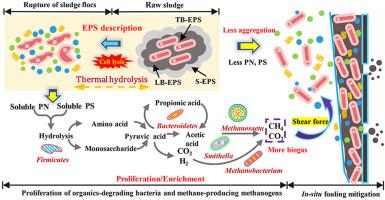当前位置:
X-MOL 学术
›
J. Membr. Sci.
›
论文详情
Our official English website, www.x-mol.net, welcomes your feedback! (Note: you will need to create a separate account there.)
Mesophilic anaerobic digestion of thermally hydrolyzed sludge in anaerobic membrane bioreactor: Long-term performance, microbial community dynamics and membrane fouling mitigation
Journal of Membrane Science ( IF 9.5 ) Pub Date : 2020-10-01 , DOI: 10.1016/j.memsci.2020.118264 Chengxin Niu , Yang Pan , Xueqin Lu , Shasha Wang , Zhongyi Zhang , Chaoting Zheng , Yujie Tan , Guangyin Zhen , Youcai Zhao , Yu-You Li
Journal of Membrane Science ( IF 9.5 ) Pub Date : 2020-10-01 , DOI: 10.1016/j.memsci.2020.118264 Chengxin Niu , Yang Pan , Xueqin Lu , Shasha Wang , Zhongyi Zhang , Chaoting Zheng , Yujie Tan , Guangyin Zhen , Youcai Zhao , Yu-You Li

|
Abstract Thermal hydrolysis (TH) was integrated into an anaerobic membrane bioreactor (AnMBR) to stimulate sludge bioconversion and methane production. Sludge solubilization degree and methane productivity increased with TH temperature. The optimal performance was observed at 125 °C, with a 2.56-time increase in soluble chemical oxygen demand (1116.2 ± 62 mg/L). Methane production rate approached 73.2 ± 7.5 mL/Lreactor/d, rising by 2.96 times. Integration of TH effectively mediated membrane fouling, inducing a stable membrane flux of 10.8 ± 0.5 L/m2/h and low transmembrane pressure (TMP, ≤4.7 kPa). Cake layer deposited on the membrane surface accounted for 66.1 ± 1.0% of total resistance, with proteins and polysaccharides as the main contributors to membrane fouling (or increased TMP) (protein: Rp = 0.89, p0.05 = 0.04; polysaccharide: Rp = 0.99, p0.05 = 0.01). 16s rRNA gene analysis demonstrated that utilization of TH could regulate microbial diversity and enhance the proliferation of organics-degrading bacteria (i.e. Bacteroidetes, Firmicutes, etc.) and methane-producing methanogens (i.e. Methanosaeta, Methanobacterium, etc.), which accelerated the biodegradation of organics while alleviating membrane fouling and upgrading methane production. This study demonstrated the great potential of the combined TH-AnMBR system as a new strategy in promoting sludge solubilization, methane bioconversion and membrane fouling mitigation.
中文翻译:

厌氧膜生物反应器中热水解污泥的中温厌氧消化:长期性能、微生物群落动态和膜污染缓解
摘要 热水解 (TH) 被集成到厌氧膜生物反应器 (AnMBR) 中以刺激污泥生物转化和甲烷生产。污泥溶解度和甲烷产率随 TH 温度的升高而增加。在 125 °C 下观察到最佳性能,可溶性化学需氧量增加了 2.56 倍(1116.2 ± 62 mg/L)。甲烷产率接近 73.2 ± 7.5 mL/Lreactor/d,提高了 2.96 倍。TH 的整合有效地介导了膜污染,产生了 10.8 ± 0.5 L/m2/h 的稳定膜通量和低跨膜压力(TMP,≤4.7 kPa)。沉积在膜表面的滤饼层占总阻力的 66.1±1.0%,蛋白质和多糖是膜污染(或增加 TMP)的主要贡献者(蛋白质:Rp = 0.89,p0.05 = 0.04;多糖:Rp = 0.99, p0.05 = 0.01)。16s rRNA基因分析表明,利用TH可以调节微生物多样性,促进有机物降解菌(拟杆菌、厚壁菌等)和产甲烷产甲烷菌(甲烷菌、甲烷杆菌等)的增殖,加速生物降解有机物,同时减轻膜污染和提高甲烷产量。这项研究证明了组合 TH-AnMBR 系统作为促进污泥溶解、甲烷生物转化和膜污染缓解的新策略的巨大潜力。Methanobacterium 等),加速有机物的生物降解,同时减轻膜污染并提高甲烷产量。这项研究证明了组合 TH-AnMBR 系统作为促进污泥溶解、甲烷生物转化和膜污染缓解的新策略的巨大潜力。Methanobacterium 等),加速有机物的生物降解,同时减轻膜污染并提高甲烷产量。这项研究证明了组合 TH-AnMBR 系统作为促进污泥溶解、甲烷生物转化和膜污染缓解的新策略的巨大潜力。
更新日期:2020-10-01
中文翻译:

厌氧膜生物反应器中热水解污泥的中温厌氧消化:长期性能、微生物群落动态和膜污染缓解
摘要 热水解 (TH) 被集成到厌氧膜生物反应器 (AnMBR) 中以刺激污泥生物转化和甲烷生产。污泥溶解度和甲烷产率随 TH 温度的升高而增加。在 125 °C 下观察到最佳性能,可溶性化学需氧量增加了 2.56 倍(1116.2 ± 62 mg/L)。甲烷产率接近 73.2 ± 7.5 mL/Lreactor/d,提高了 2.96 倍。TH 的整合有效地介导了膜污染,产生了 10.8 ± 0.5 L/m2/h 的稳定膜通量和低跨膜压力(TMP,≤4.7 kPa)。沉积在膜表面的滤饼层占总阻力的 66.1±1.0%,蛋白质和多糖是膜污染(或增加 TMP)的主要贡献者(蛋白质:Rp = 0.89,p0.05 = 0.04;多糖:Rp = 0.99, p0.05 = 0.01)。16s rRNA基因分析表明,利用TH可以调节微生物多样性,促进有机物降解菌(拟杆菌、厚壁菌等)和产甲烷产甲烷菌(甲烷菌、甲烷杆菌等)的增殖,加速生物降解有机物,同时减轻膜污染和提高甲烷产量。这项研究证明了组合 TH-AnMBR 系统作为促进污泥溶解、甲烷生物转化和膜污染缓解的新策略的巨大潜力。Methanobacterium 等),加速有机物的生物降解,同时减轻膜污染并提高甲烷产量。这项研究证明了组合 TH-AnMBR 系统作为促进污泥溶解、甲烷生物转化和膜污染缓解的新策略的巨大潜力。Methanobacterium 等),加速有机物的生物降解,同时减轻膜污染并提高甲烷产量。这项研究证明了组合 TH-AnMBR 系统作为促进污泥溶解、甲烷生物转化和膜污染缓解的新策略的巨大潜力。


























 京公网安备 11010802027423号
京公网安备 11010802027423号